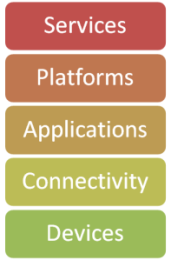 $19 Trillion is a lot of money. That’s the value Cisco expect the Internet of Things (IoT) market will generate over the next 10 years. Compare with annual world GDP of 75 Trillion, IoT will make for about 2%. Not bad. In terms of devices, the talk is for 50 billion connected devices in 2020, other estimates from ABI put the number at 30 billion and JP Morgan feels more like 75 billion in 2020; no matter, there will be a lot of devices! With this context, no wonder companies are salivating at the opportunity IoT brings about for new revenues streams and profits. But where will the value be and how can it be captured? This question is surely on the mind and lips of executives and the subject of discussion in many boardrooms.
$19 Trillion is a lot of money. That’s the value Cisco expect the Internet of Things (IoT) market will generate over the next 10 years. Compare with annual world GDP of 75 Trillion, IoT will make for about 2%. Not bad. In terms of devices, the talk is for 50 billion connected devices in 2020, other estimates from ABI put the number at 30 billion and JP Morgan feels more like 75 billion in 2020; no matter, there will be a lot of devices! With this context, no wonder companies are salivating at the opportunity IoT brings about for new revenues streams and profits. But where will the value be and how can it be captured? This question is surely on the mind and lips of executives and the subject of discussion in many boardrooms.
To help answer the question we look at the characteristics of IoT market: it is broad, fragmented, and siloed with much incompatibility between solutions. IoT, as the name implies, applies to everything and anything; it is the act of taking the ‘dumb’ and making it ‘intelligent’ in different sectors, each with its own set of requirements. ‘Intelligence’ is imparted through a process of generating and sharing information between these ‘things’ (or devices). Therefore connectivity is an essential element where today there are a number of open and proprietary standards governing connectivity between devices and networks. Connectivity enables applications that take advantage of the connected devices to create value to the end user. The applications are managed through platforms that provide critical and value added business support services such as device management, security, accounting and billing, data management and analytics, etc., to breathe life into the IoT infrastructure.
From a value perspective, value will be appropriated by each layer of the IoT model: device, connectivity, applications, platforms and services. Devices and connectivity are viewed as commodities with consequently low value appropriation whereas in applications, platforms and services is where the value lies because that’s where the ‘brains’ of the operation resides as opposed to the connected limbs and veins that represent devices and connectivity. For this reason, we see companies staking positions along the IoT fault lines, especially in the platform space where a great number of VC-funded startups have emerged, each elbowing for position to maximize its share of value. For incumbents, the challenge is how to enter the platform business since scale and monetization models are the most relevant considerations. Take for example the set of players in the platform game: Internet and OS players, the likes of Google, Amazon and Apple; the device and network infrastructure vendors such as Ericsson, Samsung, Cisco and others; the mobile operators (AT&T, Vodafone, etc.) and the services players like IBM. All these companies are vying for a share of the IoT value pie, but they do have different approach as often defined by their heritage. It would be a good question to ask who would win and get to own a disproportional share on the IoT value.
For one specific segment of companies, the mobile network operators, IoT presents a challenge and an opportunity. On one side, if connectivity is a commodity, how can they appropriate value from IoT? On the other side, each MNO is in possession of multi-billion dollar wide area network and infrastructure that is hard to replicate. They hold captive over a billion subscribers, a significant percentage of which are smartphone owners. Of course, smartphones are a critical piece for many IoT applications because smartphones enable applications. But more importantly, I think that smartphones are evolving from being compute devices to becoming a ‘digital identity’ even as there are laws against identification. Smartphones provide information on a myriad of behaviors related to the users digital life and consequently to aspects of real life (location is perhaps the least!). This provides the MNOs with added power which if carefully managed can be used to derive added value. Certainly, the concept of a smartphone as a digital identity is highly problematic and needs to be handled with care as not to trespass on privacy rights. But the idea is clear: possession of data leads to knowledge and knowledge is power (supposedly, unless it is useless knowledge!). From this perspective we see the roll of data analytics as a way to enable greater value for mobile operators. But this brings us to an all together adjacent topic that is worth a separate discussion.
(Note: The complexity of the IoT value chain masks opportunities for technology players and investors. Through our work at Xona Partners with IoT ecosystem players we developed frameworks to analyze developments in IoT based on our experience in both the telecom and IT sectors which overlap in IoT to create deep fault lines for value creation and appropriation.)
